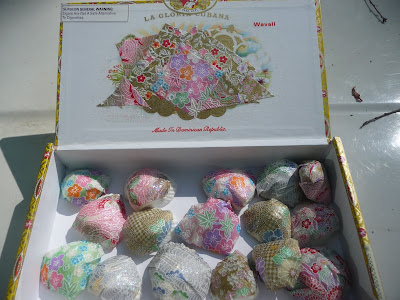My assignment was to do a game. We are great fans of the book Heart of a Samurai, which I reviewed in a previous post, so I focused on Japan. My research showed that the Japanese played many games similar to our American card games, but they didn't use the paper cards like we did until well after they had been exposed to them by Portuguese traders. Rather, they used something that was prevalent in that island nation--they used shells. But in that Japanese way of only using things of beauty, they painted their shells and made them into incredible art pieces. These had been used for many centuries, but most of the example for which I could find photographs had been made during the 19th century, so they were still the rage at that time among the upper class Japanese.
I found that they played a game that was similar to our game of Concentration. Entitled Kai Awase (which the web tells me is based on "kai" meaning "shell" and "awase" meaning "joining" or "matching"), the point of this game is to find shells with the same picture inside. The shells have been painted in a beautiful Japanese style, often using gold plate and other expensive paints, with the inside/concave side having a scene from Japanese literature, poetry, or nature scenes. The shells are placed facing down, and players have to select the matching pair. However, this was particularly difficult because a full set of traditional kai awase shells contained 360 pairs of shells, all contained in a box called a "kaioke."
Based on this information, I tried making my own set of WAY faux kai awase. First, I bought some shells at Michaels (using my 40% discount coupon, of course). I covered the outside with origami paper, which I used Sparkle Mod Podge to adfix to the the shell. I know the Japanese scene was supposed to be inside the shell, but knowing the difficulties in adhering paper to shell, I was afraid I couldn't get exactly the same part of the origami paper to fit inside the shell, and thus might throw the students off in their match-seeking. However, although not the way the real items are, the students found them quite beautiful, which was a lesson I was trying to teach them about the Japanese culture.
 |
| Kai Awase shell |
On the inside, instead of a Japanese scene or a poem that I thought wouldn't be significant for our students, I stuck on pairs of kamons, or Japanese family crests. I found a website with copyright-free kamon images, and selected some animals symbols that I thought the students would enjoy. So the inside of the shells looked like this:
 |
| Butterfly Kamon on inside of Kai Awase shell |
While a full set contained 720 shells, I'm afraid my set only had 16. However, that was sufficient to sustain the interest of our students, who played in groups of 3 or 4. I did make my version of a kaioki by adding some origami paper to a wooden cigar box that I had:
 |
| Kaioke for Kai Awase game |
 |
| Kai Awase game pieces in Kaioke box |
So, just like Concentration, the shells are placed kamon-side down, and students took turns picking two shells. If they matched, they got to keep them and score points from them. If they didn't match, they put them back, kamon-side down, and the next player got a chance to play.
I think the game worked out very well. While really nothing like their Japanese ancestors, my shells were shiny and pretty and the kids liked playing with them. They learned about kamons, and part of the game was trying to figure out what animals were displayed in the graphic images. At the end, I also gave them a chance to choose which of the images they would select for their family crest, and their choices were wide-ranging and somewhat revealing.
So if you are doing a unit on Japan, I recommend including something like this. I think it works because it contains some familiar elements--I think every middle schooler has played a matching game like this--but also illustrates some important aspects of Japanese culture in a way that is more interesting to kids than the usual lecture.
No comments:
Post a Comment